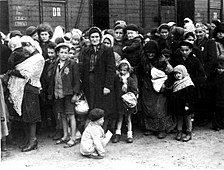
Back Treblinka-verdelgingskamp Afrikaans معسكر تريبلينكا Arabic Treblinka ölüm düşərgəsi Azerbaijani Трэблінка Byelorussian Трэблінка BE-X-OLD Треблинка Bulgarian Treblinka Breton Camp de concentració de Treblinka Catalan Vyhlazovací tábor Treblinka Czech Treblinka Welsh
| Treblinka | |
|---|---|
| Extermination camp | |
 Concrete blocks marking the path of the former railway spur at Treblinka | |
| Coordinates | 52°37′52″N 22°03′11″E / 52.63111°N 22.05306°E |
| Known for | Genocide during the Holocaust |
| Location | Near Treblinka, General Government (German-occupied Poland) |
| Built by |
|
| Operated by | SS-Totenkopfverbände |
| Commandant |
|
| Original use | Extermination camp |
| First built | April 1942 – July 1942 |
| Operational | 23 July 1942 – October 1943[3] |
| Number of gas chambers | 6 |
| Inmates | Jews (mostly Polish), Romani people |
| Number of inmates | Est. 1,000 |
| Killed | Est. 700,000–900,000 |
| Liberated by | Closed in late 1943 |
| Notable inmates | |
| Notable books | |
| Part of a series on |
| The Holocaust |
|---|
 |
Treblinka (pronounced [trɛˈbliŋka]) was the second-deadliest extermination camp to be built and operated by Nazi Germany in occupied Poland during World War II.[2] It was in a forest north-east of Warsaw, 4 km (2.5 mi) south of the village of Treblinka in what is now the Masovian Voivodeship. The camp operated between 23 July 1942 and 19 October 1943 as part of Operation Reinhard, the deadliest phase of the Final Solution.[6] During this time, it is estimated that between 700,000 and 900,000 Jews were murdered in its gas chambers,[7][8] along with 2,000 Romani people.[9] More Jews were murdered at Treblinka than at any other Nazi extermination camp apart from Auschwitz-Birkenau.[10]
Managed by the German SS with assistance from Trawniki guards – recruited from among Soviet POWs to serve with the Germans – the camp consisted of two separate units.[11] Treblinka I was a forced-labour camp (Arbeitslager) whose prisoners worked in the gravel pit or irrigation area and in the forest, where they cut wood to fuel the cremation pits.[12] Between 1941 and 1944, more than half of its 20,000 inmates were murdered via shootings, hunger, disease and mistreatment.[13][14]
The second camp, Treblinka II, was an extermination camp (Vernichtungslager), referred to euphemistically as the SS-Sonderkommando Treblinka by the Nazis. A small number of Jewish men who were not murdered immediately upon arrival became members of its Sonderkommando[15] whose jobs included being forced to bury the victims' bodies in mass graves. These bodies were exhumed in 1943 and cremated on large open-air pyres along with the bodies of new victims.[16] Gassing operations at Treblinka II ended in October 1943 following a revolt by the prisoners in early August. Several Trawniki guards were killed and 200 prisoners escaped from the camp;[17][18] almost a hundred survived the subsequent pursuit.[19][20] The camp was dismantled in late 1943. A farmhouse for a watchman was built on the site and the ground ploughed over in an attempt to hide the evidence of genocide.[21]
In the postwar Polish People's Republic, the government bought most of the land where the camp had stood, and built a large stone memorial there between 1959 and 1962. In 1964, Treblinka was declared a national monument of Jewish martyrdom[b] in a ceremony at the site of the former gas chambers.[22] In the same year, the first German trials were held regarding the crimes committed at Treblinka by former SS members. After the end of communism in Poland in 1989, the number of visitors coming to Treblinka from abroad increased. An exhibition centre at the camp opened in 2006. It was later expanded and made into a branch of the Siedlce Regional Museum.[23][24]
- ^ Webb & Chocholatý 2014, p. 20.
- ^ a b Arad 1987, p. 37.
- ^ Kopówka & Rytel-Andrianik 2011, p. 125.
- ^ Arad 1987, p. 209.
- ^ Wiernik 1945.
- ^ Sereny 2013, p. 151.
- ^ Roca, Xavier (2010). "Comparative Efficacy of the Extermination Methods in Auschwitz and Operation Reinhard" (PDF). Equip Revista HMiC (Història Moderna i Contemporània). 8. University of Barcelona. p. 204 (4/15 in current document). Archived from the original on 3 March 2016. Retrieved 8 August 2014.
- ^ Kopówka & Rytel-Andrianik 2011, p. 114.
- ^ Huttenbach, Henry R. (1991). "The Romani Porajmos: The Nazi Genocide of Europe's Gypsies". Nationalities Papers: The Journal of Nationalism and Ethnicity. 19 (3). Routledge: 380–381. doi:10.1080/00905999108408209. S2CID 163090608.
- ^ Fischel 1998, p. 173.
- ^ Browning 2017, pp. 52, 77, 79, 80.
- ^ Webb & Chocholatý 2014, p. 90.
- ^ Cite error: The named reference
Maranda-161was invoked but never defined (see the help page). - ^ Cywiński 2013.
- ^ Webb & Chocholatý 2014, pp. 153, 370.
- ^ Rees 2005, BBC.
- ^ Weinfeld 2013, p. 43.
- ^ Kopówka & Rytel-Andrianik 2011, p. 110.
- ^ Cite error: The named reference
Śląski-PAXwas invoked but never defined (see the help page). - ^ Cite error: The named reference
BBC-Eastonwas invoked but never defined (see the help page). - ^ Grossman 1946, p. 405.
- ^ Kopówka & Rytel-Andrianik 2011, p. 122.
- ^ Cite error: The named reference
memorialmuseums.orgwas invoked but never defined (see the help page). - ^ Cite error: The named reference
MWiMTwas invoked but never defined (see the help page).
Cite error: There are <ref group=lower-alpha> tags or {{efn}} templates on this page, but the references will not show without a {{reflist|group=lower-alpha}} template or {{notelist}} template (see the help page).
© MMXXIII Rich X Search. We shall prevail. All rights reserved. Rich X Search

